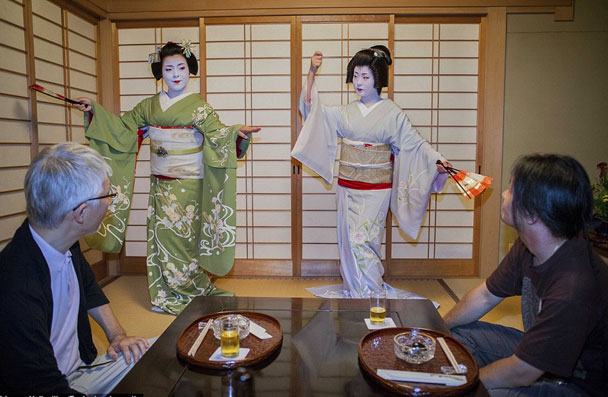
Inside the Secret world of the Geisha
They have been part of Japanese culture for 400 years but many Westerners remain in the dark about the life and role of a Geisha.
Often mistaken for prostitutes, the women in fact sell their talent for entertaining and not their bodies to the rich and powerful.
Their world is often closed to outsiders and tourists may only catch a glimpse of them in passing. But now a Spanish photojournalist has been given unprecedented access into the lives of the women who maintain centuries-old conventions in the modern era.
Lucas Vallecillos took pictures of the women as they dressed in the traditional kimono and applied their distinctive make-up comprising a white face, dark eyeliner and striking red lips.
He then followed them as they took to tea rooms to entertain their affluent clients.
The young women train for years as a Maiko after being accepted into a Okiya - a Geisha house - where they will live and are taught how to be a Geisha by an Okasan (Japanese for mother).
Before graduating to become a full-fledged Geisha, known as Geiko, the Maiko must study music, dance and how to maintain a flowing, comfortable conversation with customers. They must learn how to play instruments, how to be a perfect hostess and how to always carry themselves with grace and dignity.
While some elements may sound frivolous, the training and life of a Geisha is far from easy and it is considered a great honour and achievement to become a Geiko.
At the start of their training, the young women are expected to do housework day and night in the Okiya. They must share a room with other trainees and established Geiko - who they must also help to dress and get ready. They must always show the utmost respect to their elders, kneeling on the floor when they return to welcome them home.
The National Post reports that many of the women quit before the end of their training as they struggle to live away from home comforts and from the trappings of modern life.
They write of life for a Maiko in the geisha quarters of Kyoto's Miyagawacho: "The actual training was not glamorous at all - it was routine work day in and day out."
"The girls start with everyday greetings, move on to helping others get dressed and do things behind the scenes at dinner parties, such as setting tables, in addition to practicing dancing and playing instruments, like taiko drums, day after day."
"Two trainees left because they were not allowed to use a communication app on their smartphones, found it painful to communicate with seniors and, above all, could not stand being away from their families."
The women are also taught how to sit - as when entertaining they will often kneel in a position known as 'seiza' with their legs folded beneath their thighs.
Vallecillos' photos offers a rare insight into this world bound by tradition. Such is the way the customs have been maintained over the years, the pictures wouldn't have looked that different had they been taken decades ago.










